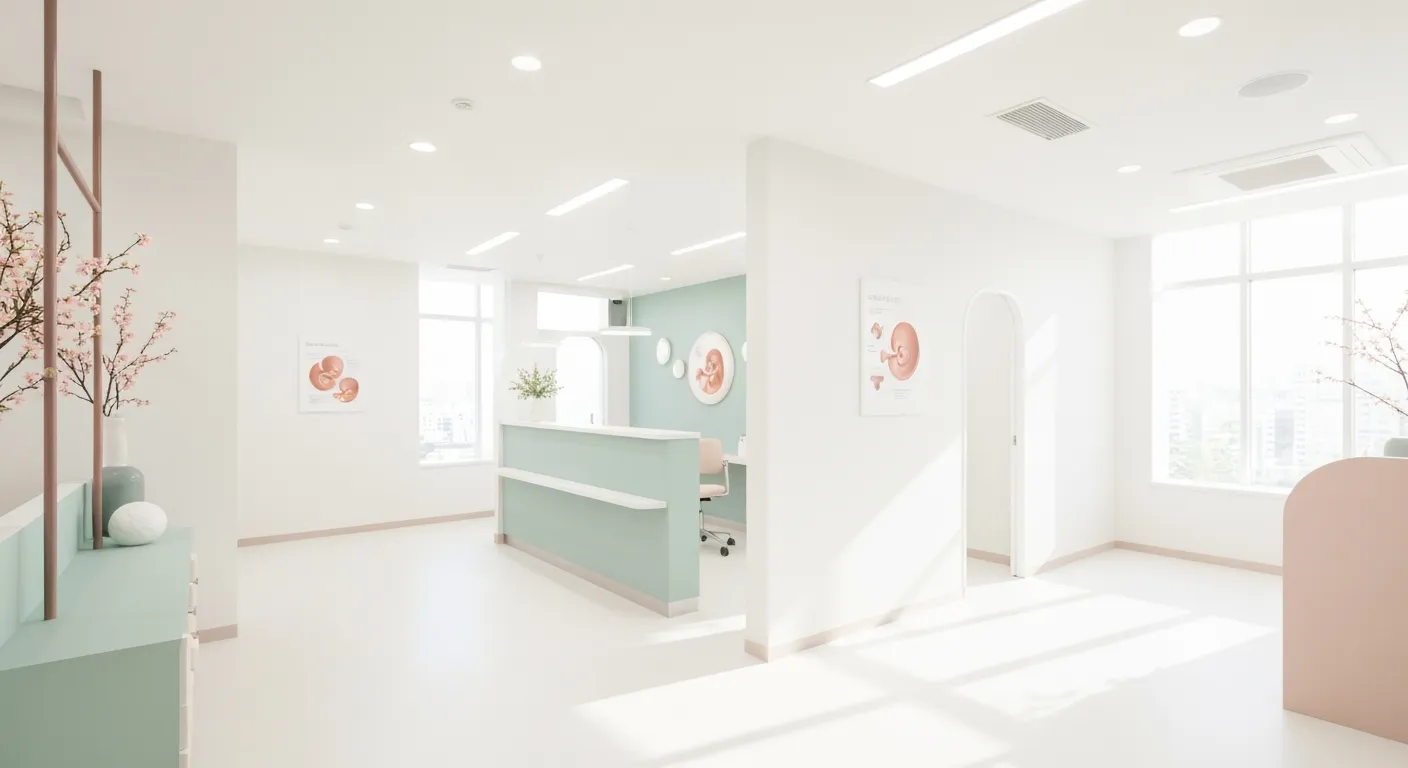Bridging Genetics and Prenatal Care: Empowering Women Through Counseling and Screening

Introduction to Fertility Evaluation
Fertility evaluations are crucial diagnostic steps for couples facing difficulties conceiving. Typically recommended after a year of unprotected intercourse for women under 35, or six months for those over 35, these evaluations aim to identify underlying causes and pave the way for effective treatments. Both partners undergo comprehensive assessments encompassing medical histories, physical examinations, and specialized tests. This guide provides a detailed overview of what to expect throughout the infertility evaluation process, helping individuals approach this journey with clarity and confidence.
When to Seek a Fertility Evaluation

Recommended Timing Based on Age and Duration of Trying to Conceive
A fertility evaluation is commonly recommended if a woman under 35 years old has not conceived after 12 months of regular, unprotected intercourse. For women aged 35 and older, this time frame shortens to six months, reflecting the natural decline in fertility with age. In women over 40, evaluation is advised immediately after trying without success due to the rapidly decreasing chances of conception (Fertility evaluation guidelines).
Circumstances Prompting Earlier Evaluation
Certain health conditions and risk factors may warrant a more urgent fertility evaluation regardless of age. These include irregular or absent menstrual cycles, known reproductive organ issues like fibroids or polycystic ovary syndrome (PCOS), previous pelvic infections or surgeries, and male partner fertility concerns. Women with a history of recurrent miscarriage, endometriosis, or other significant gynecologic problems should also seek earlier assessment (Female infertility evaluation methods).
Initial Consultation and Referral Pathways
The first step typically involves a thorough history and physical examination by an obstetrician-gynecologist. This initial assessment evaluates menstrual cycles, medical history, lifestyle factors, and sexual history. Based on findings, the patient may be referred to a reproductive endocrinologist for specialized care or, in the case of suspected male infertility, to a urologist. Early evaluation optimizes opportunities to identify causes and initiate tailored treatment plans (Initial infertility assessments and referral pathways).
Initial Assessment: Medical History and Physical Examination

What does the initial assessment in fertility evaluation include?
The first step in a fertility evaluation typically involves a comprehensive review of both partners' medical histories. This detailed history covers medical conditions, gynecologic and obstetrical events, sexual habits, medication use, lifestyle factors such as smoking and alcohol intake, and past surgeries or illnesses that might affect fertility. It also explores family history relevant to reproductive health. For more information, see Fertility consultation process and Medical history review.
What physical examinations are conducted for fertility assessment?
Physical exams are conducted for both women and men to identify any physical issues affecting fertility. For women, the exam often includes pelvic examination, assessing breast health, and evaluation of thyroid or other possible hormonal issues. For men, physical exams focus on the reproductive organs, including testicular examination and penile assessment, to check for abnormalities or signs of infection. Related resources include Physical exams for fertility and Physical exam for infertility.
Why is honest communication important during fertility evaluation?
Honest and thorough communication during the evaluation is crucial. This openness allows healthcare providers to fully understand potential factors affecting fertility and to recommend appropriate tests and treatments. Discussing lifestyle habits and symptoms candidly helps tailor the evaluation and improve the chances of conception by addressing underlying issues effectively. For guidance, see Patient support in fertility evaluation and Lifestyle factors affecting fertility.
Overall, this initial assessment forms the foundation for targeted diagnostic testing and personalized treatment planning, ensuring a comprehensive approach to resolving infertility. Learn more about the Customized fertility treatment plan and Fertility evaluation guidelines.
Female Fertility Testing: Hormonal and Structural Evaluations

What Hormonal Blood Tests Are Used in Female Fertility Evaluation?
Hormonal blood tests play a critical role in assessing female fertility by evaluating ovarian function and hormonal balance. Common tests include:
- FSH (Follicle Stimulating Hormone): Assesses ovarian reserve and function, usually measured on day 3 of the menstrual cycle (Hormonal fertility tests, Blood tests for ovarian reserve).
- LH (Luteinizing Hormone): Works with FSH to regulate ovulation (LH hormone test, FSH and LH hormone tests).
- AMH (Anti-Müllerian Hormone): Indicates the remaining egg supply and ovarian reserve; not cycle-dependent (AMH hormone test, Ovarian reserve assessment.
- Estradiol: Reflects estrogen production, important for ovulation and uterine lining development (Estradiol level testing, Estradiol measurement).
- Progesterone: Measures after ovulation to confirm its occurrence (Progesterone in fertility, Progesterone blood test.
- Prolactin: Elevated levels can impair fertility (Elevated prolactin levels impact, Hormone testing for prolactin).
- Thyroid Function Tests (TSH): Thyroid disorders can affect reproductive hormones and fertility (Thyroid function evaluation, Thyroid function testing.
How Is Ovarian Reserve Assessed?
Ovarian reserve indicates fertility potential and is evaluated by:
- AMH Blood Test: Provides a reliable snapshot of egg quantity (AMH hormone test, Ovarian reserve assessment).
- Day 3 FSH and Estradiol: Higher FSH or estradiol levels may indicate diminished reserve (Day 3 FSH test, Estradiol level testing).
- Antral Follicle Count (AFC): Determined using transvaginal ultrasound to count developing follicles (Antral follicle count ultrasound, Ultrasound in fertility testing.
What Imaging Studies Are Performed?
Imaging helps detect structural abnormalities and assesses reproductive organs:
- Transvaginal Ultrasound: Visualizes ovaries, follicles, uterine lining, fibroids, cysts, or polyps (Transvaginal Ultrasounds, Ultrasound screening for men.
- Hysterosalpingogram (HSG): X-ray with contrast to check fallopian tube openness and uterine shape (Hysterosalpingogram (HSG), HSG procedure.
- Sonohysterography: Ultrasound with saline infusion to assess uterine cavity (Sonohysterogram imaging).
- Hysteroscopy: Direct visualization of the uterine cavity with a lighted scope, allows diagnosis and treatment (Hysteroscopy procedures, Hysteroscopy for diagnosis.
- Laparoscopy: Minimally invasive surgery to view pelvic organs, diagnose and treat conditions like endometriosis, adhesions, or tubal damage (Laparoscopy procedures, Laparoscopy in infertility diagnosis).
How Are Fallopian Tubes and Uterine Abnormalities Assessed?
Fallopian tube patency and uterine structural issues are key factors affecting fertility. Methods include:
- HSG: Primary test for detecting blockages in fallopian tubes and evaluating uterine shape (HSG test explanation, Hysterosalpingography for fertility.
- Sonohysterography: Provides detailed uterine cavity imaging, identifying polyps or adhesions (Sonohysterography uses).
- Hysteroscopy: Confirms and treats intrauterine abnormalities such as fibroids and septa (Hysteroscopy exam, Hysteroscopy and laparoscopy.
- Laparoscopy with Chromopertubation: Considered the gold standard for evaluating tubal patency and diagnosing pelvic pathologies (Laparoscopy indications in infertility, Pelvic organ examination laparoscopy.
These hormonal and structural evaluations offer a comprehensive understanding of female fertility potential and guide personalized treatment plans (Comprehensive fertility evaluation, Fertility center services.
Male Fertility Evaluation: Semen and Hormonal Analysis
Semen Analysis Parameters
The cornerstone of male fertility evaluation is a semen analysis. This test measures several critical factors:
- Sperm Count: A normal sperm concentration is typically above 15 million sperm per milliliter.
- Motility: Total motility should be at least 40% to indicate good sperm movement.
- Morphology: Normal sperm shape must be at least 4% based on strict criteria.
- Volume: Semen samples generally range between 1.5 to 5 milliliters.
- pH: A healthy semen pH ranges from 7.2 to 8.0, reflecting proper seminal fluid environment.
Semen samples must be collected after 2 to 5 days of abstinence for accurate results.
Hormonal Testing
Hormonal assessments help uncover endocrine causes of infertility. Important hormones tested include:
- Testosterone: Low levels may indicate hypogonadism.
- Follicle-Stimulating Hormone (FSH): Elevated levels can suggest testicular failure.
- Luteinizing Hormone (LH): Provides information on pituitary regulation.
- Prolactin: Elevated prolactin can impair sperm production.
- Estradiol: Assessed for hormonal balance.
These tests provide insight into hormone function affecting sperm production and overall male reproductive health. See more about hormone testing for male fertility.
Additional Diagnostic Tests
If semen analysis or hormone tests are abnormal, further investigations may be undertaken:
- Scrotal Ultrasound: Evaluates for varicocele, testicular masses, or structural abnormalities.
- Genetic Testing: Identifies chromosomal or gene defects affecting fertility.
- Testicular Biopsy: Performed rarely to diagnose sperm production issues in azoospermia.
These tests help pinpoint underlying conditions to guide appropriate treatment strategies. For more on diagnostic testing for male infertility and imaging techniques see the detailed guides.
Natural Cycle Tracking and Ovulation Confirmation
Methods for Tracking Ovulation Including Basal Body Temperature Monitoring and Cervical Mucus Observation
Tracking ovulation naturally can be done through methods such as basal body temperature (BBT) monitoring and observing changes in cervical mucus. BBT involves measuring your temperature each morning before getting out of bed; a slight rise in temperature typically indicates ovulation has occurred.
Cervical mucus observation entails noting its consistency and appearance, which changes throughout the menstrual cycle. Around ovulation, mucus becomes clear, stretchy, and abundant, signaling fertile days.
Use of Urine LH Surge Tests for Predicting Ovulation
Urine luteinizing hormone (LH) surge tests detect the LH hormone spike 24 to 48 hours before ovulation. This test helps predict the best days to time intercourse for conception. It is a convenient, at-home method to identify the fertile window.
Progesterone Blood Tests to Confirm Ovulation
A blood test measuring progesterone levels is typically done about a week before the expected period to confirm that ovulation has occurred. Elevated progesterone indicates that an egg was released.
Role of These Techniques in Infertility Evaluation and Timing of Intercourse
These ovulation tracking and confirmation methods are vital parts of an infertility evaluation, helping assess whether ovulation is occurring regularly and aiding couples in timing intercourse for optimal chances of conception. They provide non-invasive and cost-effective ways to monitor fertility during the diagnostic process.
Interpreting Results and Developing a Treatment Plan

Understanding Common Causes Identified Through Testing
Infertility evaluations often identify several common causes affecting both partners. For women, ovulatory disorders like polycystic ovary syndrome (PCOS) are prevalent, leading to anovulation or irregular cycles. Tubal disease, including blockages or damage to the fallopian tubes, is another significant cause and is frequently identified through imaging tests such as hysterosalpingography. In men, sperm-related issues such as low sperm count, poor motility, or abnormal morphology are common findings assessed initially with semen analysis.
Unexplained Infertility and Its Implications
In some cases, even after comprehensive testing, no clear cause for infertility is found, a condition termed unexplained infertility. This affects roughly 15-30% of couples. While it can be frustrating, unexplained infertility still allows for various treatment options and highlights the complexity of reproductive processes beyond standard diagnostics.
Tailoring Treatment Options
Treatment plans are personalized based on diagnosis, patient age, lifestyle, and reproductive goals. Lifestyle modifications like achieving a healthy weight, quitting smoking, reducing alcohol consumption, and managing exercise levels are fundamental first steps. Medications such as ovulation induction agents (e.g., clomiphene or letrozole) address hormonal imbalances. Surgical options may correct anatomical problems like fibroids or blocked tubes. Assisted reproductive technologies, including intrauterine insemination (IUI) and in vitro fertilization (IVF), are considered especially when other treatments are ineffective or in cases of severe pathology.
Importance of Age and Ovarian Reserve in Treatment Decisions
Age plays a crucial role in treatment success. Female fertility typically declines after age 35, with ovarian reserve tests like Anti-Müllerian Hormone (AMH) levels and antral follicle counts providing important information on reproductive potential. Women over 38-40 years often face reduced chances of natural conception, prompting more immediate use of advanced treatments like IVF. Tailored approaches balance treatment effectiveness with individual circumstances, maximizing the chance of a successful pregnancy.
Practical Considerations: Timing, Costs, and Support
How long does the fertility evaluation process take?
The fertility evaluation process generally spans a few menstrual cycles. This timeframe allows for comprehensive testing, including hormone level assessments timed to specific cycle days (Hormone level testing for fertility, imaging studies such as ultrasounds (Ultrasound in fertility assessment, and semen analyses (Semen analysis for men. Some tests may need to be repeated or coordinated with menstrual cycle phases to accurately assess ovulation and reproductive organ function (Ovulation confirmation.
What should patients know about insurance and costs?
Insurance coverage for fertility evaluation can vary widely depending on the provider and plan. While many insurance plans cover initial testing and consultations (Insurance accepted for fertility care, some specialized tests or treatments may not be fully covered, potentially resulting in out-of-pocket expenses. Patients are advised to verify insurance benefits prior to testing to understand the extent of coverage and any associated costs (Insurance coverage for infertility testing.
Are emotional and psychological supports available?
The journey through fertility evaluation can be challenging emotionally and psychologically. Many fertility centers emphasize patient support by offering counseling services and mental health resources (Patient support in fertility evaluation to help individuals and couples cope with stress, anxiety, and emotional difficulties that can arise during the evaluation and treatment process.
When is early fertility evaluation recommended?
Early fertility evaluation is encouraged for women aged 35 or older after six months of attempting conception, and immediately for those over 40 or with known risk factors such as irregular menstrual cycles or previous reproductive health issues (When to consider evaluation. Prompt evaluation facilitates timely diagnosis and personalized treatment planning to maximize chances of conception (Customized fertility treatment plan.
Conclusion: Empowering Your Fertility Journey
Embarking on a fertility evaluation can feel overwhelming, but understanding the comprehensive process helps demystify what lies ahead. Through a systematic approach involving detailed history, targeted testing, and personalized treatment planning, many underlying causes of infertility can be identified and addressed. Regardless of results, patients are supported through medical guidance and emotional counseling, ensuring a holistic approach. Early evaluation, especially for women over 35 or with known risk factors, enhances the potential for successful conception. Informed and prepared individuals are better positioned to navigate the path to parenthood with hope and resilience.





.png)